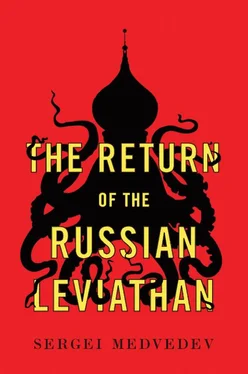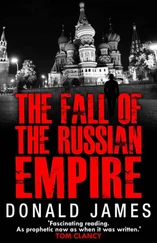Back in the far-off days of 1990s techno-optimism, we believed that the computer (in partnership with the video recorder) would bring us freedom. Russians, being masters of the grey import, flooded the country with IBM computers with AT and XT processors. The first programs were written by long-haired guys with holes in their sweaters, physics students from Phystech, the elite technical college, who had just opened their first cooperative businesses. They were the heralds of the open information society, the pioneers of the digital frontier. We greeted the successes of our native IT entrepreneurs – Ilya Segalovich, Arkady Volozh, Anatoly Karachinsky and Eugene Kaspersky – as a counterweight to raw state capitalism. The Yandex and ABBYY brands seemed to be the Russian bridges into the world of globalization; and the Facebook symbol invariably appeared on the banners of the demonstrators at the protests on Bolotnaya Square in the winter of 2011–12. [37] Following allegations of rigged elections for the State Duma in December 2011, there were mass demonstrations in Moscow, the like of which had not been seen since the last days of the Soviet Union. These demonstrations seemed to convince President Putin that he needed to have a stronger grip on society.
Now everything has changed. The lesson has been well learned by the domestic IT industry of Pavel Durov, the creator of the social network vKontakte (‘In Touch’, considered the ‘Russian Facebook’). This libertarian clashed with the FSB, had his business taken from him and ended up being chased out of the country as a digital dissident. Now those programmers – still wearing the same sweaters with holes in them – write the code for ‘SORM’: Operational Search Systems, a complex of measures giving the special services control over telephones, mobile and wireless networks; and they are building the new Russian panopticon, a digital prison with a system for total monitoring of the population.
The optimism of the 1990s about the liberating actions of the Internet rested on the illusions that the new technologies, which are at one and the same time personalized yet provide a network, would produce a new type of social relationship: non-hierarchical, egalitarian, participatory; and that they would create a new type of politics, which would shake up the old hierarchy of parties, elites and states, which the industrial age left us as its legacy. And indeed, in the past twenty years completely different forms of politics have appeared, based on the new technologies, from the networked campaigning of Barack Obama in 2008 and the success of the Pirate Party in Iceland, to the ‘Twitter Revolutions’ in the Arab world. But Obama left office, Facebook helped bring to power the populist and chauvinist Donald Trump, and Twitter in the Arab states was taken over by the Islamists. At the same time, authoritarian regimes learnt how to live with the net; not just live with it, but use it to their own advantage: personalization and customization can be turned into personal control over citizens by means of their gadgets and their social network accounts. And social media activity, it turns out, can easily be transformed into noise on the net, when different forms of civil activity on the Internet can become lightning rods, a valve for letting off steam – a substitute for political protest. And at the same time, hi-tech companies can be changed from being agents for change into agents of the state, as happened, for example, with Kaspersky Lab in Russia.
Here we see a fundamental rule of ‘network neutrality’: technology is neutral, not only in relation to its content and application formats, as the very term implies, but in relation to political regimes, too. The network can be used both to liberate people and also to spy on them; both to consolidate a protest and to disperse it. Technology itself is neither good nor bad, in the same way that an axe is neither good nor bad: it is simply an instrument in a person’s hands. The same axe can be used to chop the wood to make a cottage or to kill someone. The network does not exist separately from society, the elite, or the state. It transmits the vast majority of social relationships, but it does not define them. For example, the Islamic State has shown itself to be very advanced technologically, combining the social and religious practices of the Middle Ages with skilled management of the media and social networks.
In Russia the interrelationship of technology and the governing regime has its own peculiarities. First, it is a question of resources. In terms of the distribution model of the economy and the skilfully manipulated paranoia about ‘national information security’, the IT sector becomes a vital feeder of the budget alongside other strategic sectors: atomic energy, the air and space sector and the military-industrial complex. The IT sector gives rise to a large number of go-betweens who peddle ‘threats’ (people such as Duma deputy Irina Yarovaya; the creator of the League for a Safe Internet, Konstantin Malofeev; or the Communications Minister, Nikolai Nikiforov, who suggested that .doc files and the Times New Roman font could undermine the Russian Federation’s information sovereignty). These people dream up threats to information security to obtain resources from the budget. Storing Russians’ personal data; archiving for three years the contents of telephone and Internet communications (‘the Yarovaya Law’); relocating credit card transaction transfers to Russian servers; the creation of a national search engine and operation system; the transfer of state structures onto a national software system; and the possibility of creating the infrastructure for a sovereign Internet along the Chinese model: all of this gobbles up a huge slice of the budget pie, which no hi-tech company would turn away from.
Second, this is a question of the innovation culture. An engineer in Russia is a state worker. In Russian history, technology and modernization (particularly in the military-industrial context) were always first and foremost strategic priorities for the state, and only in a distant second place matters for private capital. For centuries, it was with this in mind that the state trained its engineers. As the Russian investigative journalist, Andrei Soldatov, has said:
Russian and Soviet engineers were never taught ethics and were never given normal philosophy courses. All that a Russian engineer knows is that, ‘there are these chattering artists, while we ensure order’. And, of course, the idea of ‘order’ chimes perfectly with the state’s way of thinking, because it is a hierarchy with a clearly defined structure. Many engineers have told me that if you ask an engineer with no training in the humanities to build you a defence system, he’ll produce a prison, because nothing is better protected: there’s one way in, one way out, and everything is controlled. [38] https://www.svoboda.org/a/27686926.html Radio Liberty, ‘Kremlin Firewall’ (in Russian), 20 April 2016.
Soldatov makes the comparison with Napoleon, who closed down the schools of philosophy and opened engineering schools, because he didn’t need revolutionaries; and with Stalin, who created a huge number of polytechnical colleges in order to teach people technical skills but without a university education. So the problem is far from being a specifically Russian one; but it was particularly in the USSR, where technical modernization became a question of national security, that the state almost completely took responsibility for the engineering culture. This went from Stalin’s sharashki (special camps for scientists who were carrying out strategic research), to Khrushchev’s and Brezhnev’s scientific-research institutes, to the ‘closed towns’ under the control of the military-industrial complex, [39] The vast majority of the territory of the Soviet Union was ‘closed’ to foreigners: they were not allowed to go there. There were also numerous ‘closed towns’ – sometimes large cities – where even Soviet citizens needed a special pass to live or visit. For foreigners there was no such thing as a visa for the Soviet Union. The visa stipulated the places to be visited and was valid for travel only within a twenty-five-kilometre radius of the centre of that place – provided no ‘closed’ areas fell within it.
to the ‘post boxes’ – secret institutes and factories that were known only by their postcode.
Читать дальше












